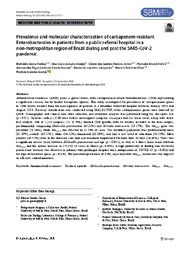Prevalence and molecular characterization of carbapenem-resistant Enterobacterales in patients from a public referral hospital in a non-metropolitan region of Brazil during and post the SARS-CoV-2 pandemic.
Prevalence and molecular characterization of carbapenem-resistant Enterobacterales in patients from a public referral hospital in a non-metropolitan region of Brazil during and post the SARS-CoV-2 pandemic.
Author(s): FOCHAT, R. C.; ARAÚJO, A. C. de L.; PEREIRA JÚNIOR, O. dos S. P.; SILVÉRIO, M. S.; NASSAR, A. F. de C.; JUNQUEIRA, M. de L.; SILVA, M. R.; GARCIA, P. G.
Summary: Antimicrobial resistance (AMR) poses a global threat, with carbapenem-resistant Enterobacterales (CRE) representing a significant concern due to limited therapeutic options. This study investigated the prevalence of carbapenemase genes in CRE strains isolated from tracheal aspirates of patients at a Brazilian university hospital between January 2020 and August 2023. Bacterial identification was conducted using MALDI-TOF, while carbapenemase genes were detected by qPCR. Demographic and clinical data were collected, and univariate analysis was performed using the chi-square test (p<0.05). Variables with p?0.10 were further investigated using the chi-square test for linear trend, along with stratified analysis. Out of 1,133 samples, 111 (9.79%) showed CRE growth, with 46 isolates included in the final sample, predominantly comprising Klebsiella pneumoniae (65.21%) and Serratia marcescens (19.57%). The blaKPC gene was prevalent (78.26%), while blaNDM was detected in 21.74% of cases. The identified population was predominantly male (67.39%), elderly (69.57%), white (56.52%), unmarried (63.04%), and had a low level of education (56.52%). Most patients (69.57%) were in the intensive care unit and remained hospitalized for more than 30 days (76.08%). There was a significant inverse trend between Klebsiella pneumoniae and age (p=0.045), as well as a direct linear trend between blaNDM and the annual increase in COVID-19 cases in Brazil (p=0.050). A high probability of finding non-Klebsiella pneumoniae bacteria was observed in patients with prolonged hospital stays, independent of COVID-19 (p=0.006) and the type of resistance genes (p=0.020). The persistent prevalence of CRE, especially with blaKPC, underscores the urgency of effective control measures.
Publication year: 2024
Types of publication: Journal article
Unit: Embrapa Dairy Cattle
Observation
Some of Embrapa's publications are published as ePub files. To read them, use or download one of the following free software options to your computer or mobile device. Android: Google Play Books; IOS: iBooks; Windows and Linux: Calibre.
Access other publications
Access the Agricultural Research Database (BDPA) to consult Embrapa's full library collection and records.
Visit Embrapa Bookstore to purchase books and other publications sold by Embrapa.

